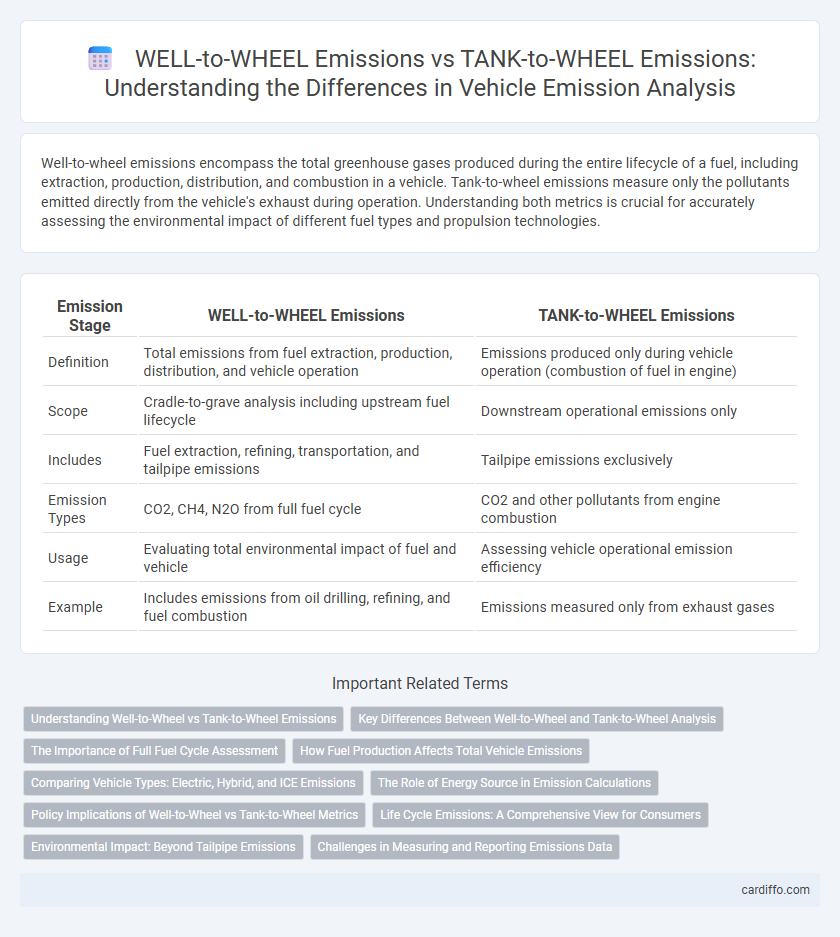Well-to-wheel emissions encompass the total greenhouse gases produced during the entire lifecycle of a fuel, including extraction, production, distribution, and combustion in a vehicle. Tank-to-wheel emissions measure only the pollutants emitted directly from the vehicle's exhaust during operation. Understanding both metrics is crucial for accurately assessing the environmental impact of different fuel types and propulsion technologies.
Table of Comparison
| Emission Stage | WELL-to-WHEEL Emissions | TANK-to-WHEEL Emissions |
|---|---|---|
| Definition | Total emissions from fuel extraction, production, distribution, and vehicle operation | Emissions produced only during vehicle operation (combustion of fuel in engine) |
| Scope | Cradle-to-grave analysis including upstream fuel lifecycle | Downstream operational emissions only |
| Includes | Fuel extraction, refining, transportation, and tailpipe emissions | Tailpipe emissions exclusively |
| Emission Types | CO2, CH4, N2O from full fuel cycle | CO2 and other pollutants from engine combustion |
| Usage | Evaluating total environmental impact of fuel and vehicle | Assessing vehicle operational emission efficiency |
| Example | Includes emissions from oil drilling, refining, and fuel combustion | Emissions measured only from exhaust gases |
Understanding Well-to-Wheel vs Tank-to-Wheel Emissions
Well-to-Wheel emissions encompass the total greenhouse gas output from fuel extraction, production, distribution, and vehicle operation, providing a comprehensive assessment of a vehicle's environmental impact. Tank-to-Wheel emissions focus solely on the pollutants produced during the combustion of fuel within the vehicle's engine, excluding upstream processes. Understanding the distinction between these metrics is crucial for accurately evaluating the sustainability of various fuel sources and vehicle technologies.
Key Differences Between Well-to-Wheel and Tank-to-Wheel Analysis
Well-to-Wheel emissions encompass the total greenhouse gases released from fuel extraction through vehicle operation, providing a comprehensive assessment of environmental impact. Tank-to-Wheel emissions measure only the pollutants emitted during vehicle combustion, excluding upstream processes such as refining and fuel transport. This distinction is critical for accurately evaluating the sustainability of various fuel types and propulsion technologies in transportation.
The Importance of Full Fuel Cycle Assessment
Well-to-wheel emissions encompass the entire fuel lifecycle from extraction and production to consumption, providing a comprehensive measurement of environmental impact. Tank-to-wheel emissions only account for the pollutants released during vehicle operation, excluding upstream processes such as refining and transportation. Full fuel cycle assessment is vital for accurate evaluation of true emissions and informed policy-making in sustainable transportation planning.
How Fuel Production Affects Total Vehicle Emissions
Well-to-wheel emissions encompass the entire lifecycle of fuel production, including extraction, refining, and distribution, significantly impacting total vehicle emissions. Tank-to-wheel emissions measure only the pollutants released during vehicle operation, excluding upstream impacts from fuel production. Evaluating both perspectives is crucial to accurately assess the environmental footprint of different fuel types and vehicle technologies.
Comparing Vehicle Types: Electric, Hybrid, and ICE Emissions
Well-to-wheel emissions encompass the entire fuel lifecycle, including extraction, production, and consumption, making them a comprehensive metric for comparing electric, hybrid, and internal combustion engine (ICE) vehicles. Electric vehicles (EVs) typically show lower well-to-wheel emissions due to higher efficiency and cleaner electricity grids, whereas hybrid vehicles exhibit intermediate values by combining electric and fuel combustion phases. ICE vehicles generally present the highest emissions across both well-to-wheel and tank-to-wheel analyses, driven by direct fuel burning and less efficient energy conversion.
The Role of Energy Source in Emission Calculations
Well-to-Wheel emissions encompass the total greenhouse gases produced from energy extraction through vehicle operation, highlighting the significant influence of the energy source's carbon intensity on overall emissions. Tank-to-Wheel emissions measure only the pollutants emitted during fuel combustion within the vehicle, often overlooking upstream processes like fuel production and distribution. The primary energy source--whether fossil fuels, biofuels, or renewable electricity--directly impacts Well-to-Wheel calculations, making it essential for accurate life-cycle emission assessments and effective environmental policy development.
Policy Implications of Well-to-Wheel vs Tank-to-Wheel Metrics
Well-to-Wheel emissions provide a comprehensive assessment by including upstream production and fuel supply processes, influencing policies towards cleaner energy sources and infrastructure investments. Tank-to-Wheel metrics focus solely on vehicle operation emissions, potentially overlooking upstream environmental impacts, which can lead to policies favoring only tailpipe emission reductions. Prioritizing Well-to-Wheel analysis supports holistic regulatory frameworks promoting sustainable fuel production, lifecycle emissions reduction, and incentivizing renewable energy integration within transportation policies.
Life Cycle Emissions: A Comprehensive View for Consumers
Life Cycle Emissions provide a comprehensive view of the environmental impact by measuring WELL-to-WHEEL emissions, which include the entire fuel production, distribution, and vehicle operation process. Tank-to-Wheel emissions only account for the direct exhaust produced during vehicle use, overlooking upstream effects such as extraction, refining, and transportation of fuel. Consumers informed about WELL-to-WHEEL emissions can better evaluate true environmental costs and make sustainable choices in vehicle selection.
Environmental Impact: Beyond Tailpipe Emissions
WELL-to-WHEEL emissions encompass the total environmental impact by measuring greenhouse gases released during fuel production, distribution, and vehicle operation, providing a comprehensive assessment beyond TANK-to-WHEEL emissions, which only account for tailpipe outputs. This holistic approach highlights the significance of fuel extraction, refining processes, and energy source sustainability in mitigating overall carbon footprints. Evaluating WELL-to-WHEEL emissions is crucial for developing effective policies aimed at reducing global warming and air pollution in the transportation sector.
Challenges in Measuring and Reporting Emissions Data
Accurately measuring WELL-to-WHEEL emissions involves tracking the full lifecycle of fuel production, distribution, and consumption, demanding extensive data integration across multiple sectors. TANK-to-WHEEL emissions focus solely on the direct emissions during vehicle operation, potentially underrepresenting the environmental impact by excluding upstream processes. Discrepancies between these measurement scopes challenge consistent reporting and comparison of emission data for regulatory and sustainability assessments.
WELL-to-WHEEL emissions vs TANK-to-WHEEL emissions Infographic

 cardiffo.com
cardiffo.com